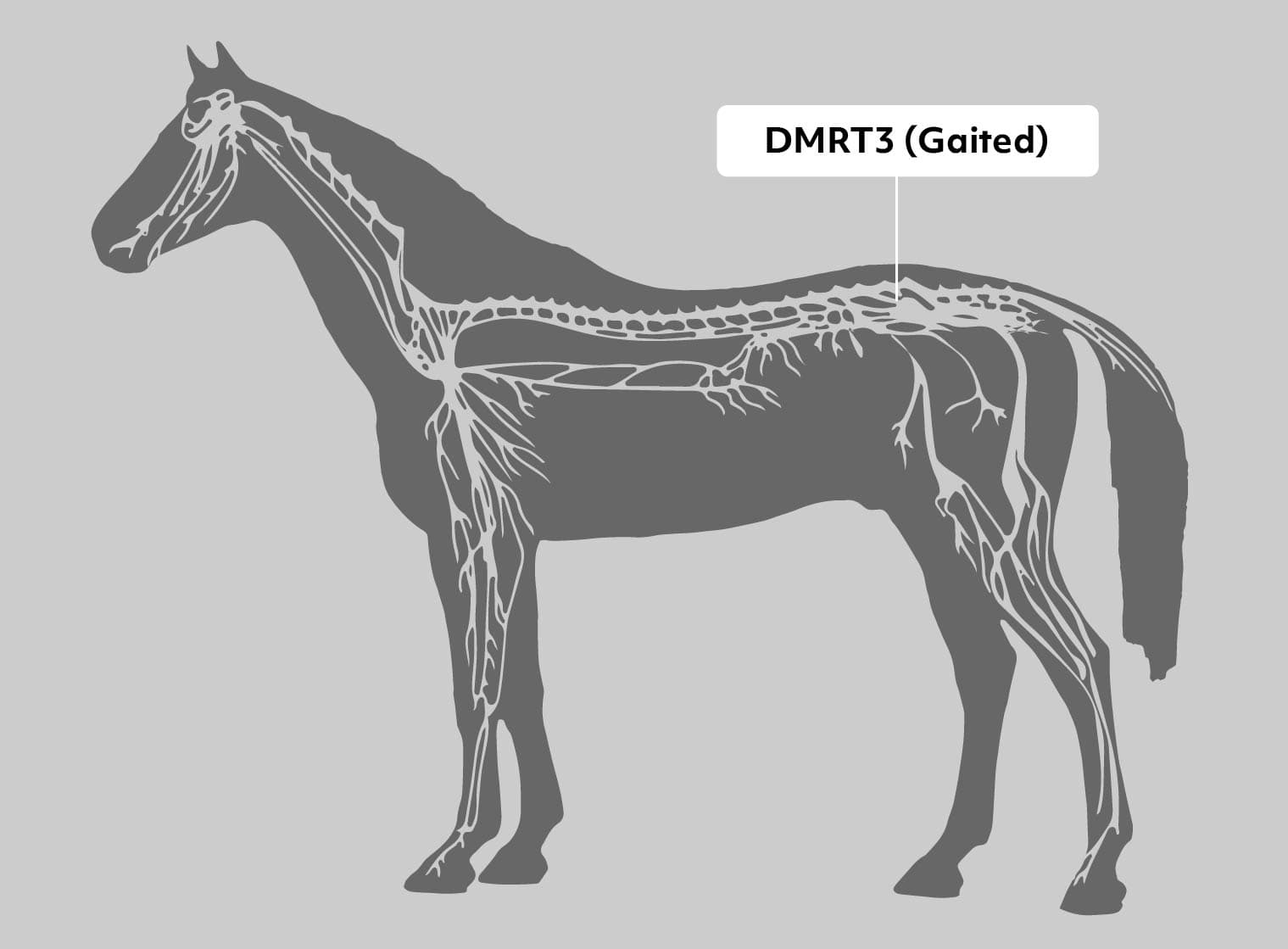DMRT3 "Gait" (DRMT3)
Gene or Region: DMRT3
Reference Variant: C
Mutant Variant: A
Affected Breeds: Many
Research Confidence: High - Findings reproduced in multiple studies
Explanation of Results: DMRT3/DMRT3 = homozygous for "Gait," trait expressed DMRT3/n = heterozygous for "Gait," trait expressed n/n = no variant present
General Description for Gait (DMRT3)
Horses display a wide variation in locomotion, with “gaited” breeds displaying a range of unique footfall patterns at intermediate speeds. Even amongst the "non-gaited" breeds, some individuals are capable of unique lateral movements. Also, while most horses will shift into the three beat canter at higher speeds, some horses are able to remain in their intermediate gaits (for example, harness racing breeds) without breaking into a canter.
DMRT3 is a transcription factor located within the spinal cord, and therefore, a neurologically active genetic variant. Mice lacking DMRT3 display incoordination of the limbs and difficulty running at higher speeds. In the Icelandic Horse, the C allele is associated with better synchronization of diagonal legs and higher ratings of the trot and gallop, whereas the A allele is associated with higher speed and coordination at the tölt (a lateral intermediate gait). This mutation results in a premature stop codon, which truncates the encoded protein.
The exact phenotype of the DMRT3 mutation is, to date, somewhat controversial. Currently published research has identified this mutation as the causal variation responsible for the ability to perform intermediate lateral gaits and has been subsequently called "the gait gene" by some. However, even within these studies, there were and are horses from gaited breeds, clearly displaying "gaited" movement but are negative, or C/C, for DMRT3. Also, this variation was originally identified in the Icelandic Horse as associated with the ability to perform a flying pace, which is a lateral intermediate speed gait performed at a higher speed. All Icelandic Horses in this study (citation below), even those unable to perform the flying pace, were able to perform the lateral tölt.
Additionally, preliminary testing has uncovered the DMRT3 mutation in breeds not known for gaiting. It is also suspected that there may be additional or different "gait" variations/genes still undiscovered in many breeds. Etalon is currently conducting a large-scale research study in collaboration with horse owners, veterinarians, and other equine scientists and a publication is forth-coming shortly.
Learn more about the Gait gene on our blog.
References
Andersson LS et al., “Mutations in DMRT3 affect locomotion in horses and spinal circuit function in mice.” (2012) Nature. 488: 642-6. PMID: 22932389
Promerová M et al., “Worldwide frequency distribution of the 'Gait keeper' mutation in the DMRT3 gene.” (2014) Anim Genet. 45: 274-82. PMID: 24444049
Kristjansson T et al., “The effect of the 'Gait keeper' mutation in the DMRT3 gene on gaiting ability in Icelandic horses.” (2014) J Anim Breed Genet. doi: 10.1111/jbg.12112. [Epub ahead of print] PMID: 25073639
More Equine Performance
Equine Temperament
Temperament is a complex trait influenced by multiple genetic and environmental factors. Individual components of temperament are potentially under different controls. Curiosity in the horse has been defined as an interest in novel objects and a willingness to approach them. Vigilance refers to the tendency of a horse to examine its surroundings.
Horse Height (HMGA2)
The domestic horse displays a wide range of size variation, from the tiny Miniature Horses to the towering draft breeds. While height is a complex trait involving a variety of genetic and environmental factors, the breeding systems of domestic animals has led to a small number of genes being responsible for large amounts of variation in several species.
Horse Height (LCORL)
The domestic horse displays a wide range of size variation, from the tiny Miniature Horses to the towering draft breeds. While height is a complex trait involving a variety of genetic and environmental factors, the breeding systems of domestic animals has led to a small number of genes being responsible for large amounts of variation in several species.
Myostatin Insertion: The Speed Gene
Thoroughbred races are held at a variety of distances, with individual racehorses usually displaying a preference for a range. There is some suggestion that sprint horses (which compete at distances less than 6 furlongs, or 2/3rds of a mile) are more compact and muscular than horses that run at longer distances. This insertion has been associated with racing distance for winning Thoroughbreds at the top level of competition, with C/C horses excelling at distances of 8 furlongs or less and T/T horses found more in races of 9 furlongs or more. Horses with one copy of each genetic variant won at all distances. Research Confidence: High confidence, findings reproduced in multiple studies
